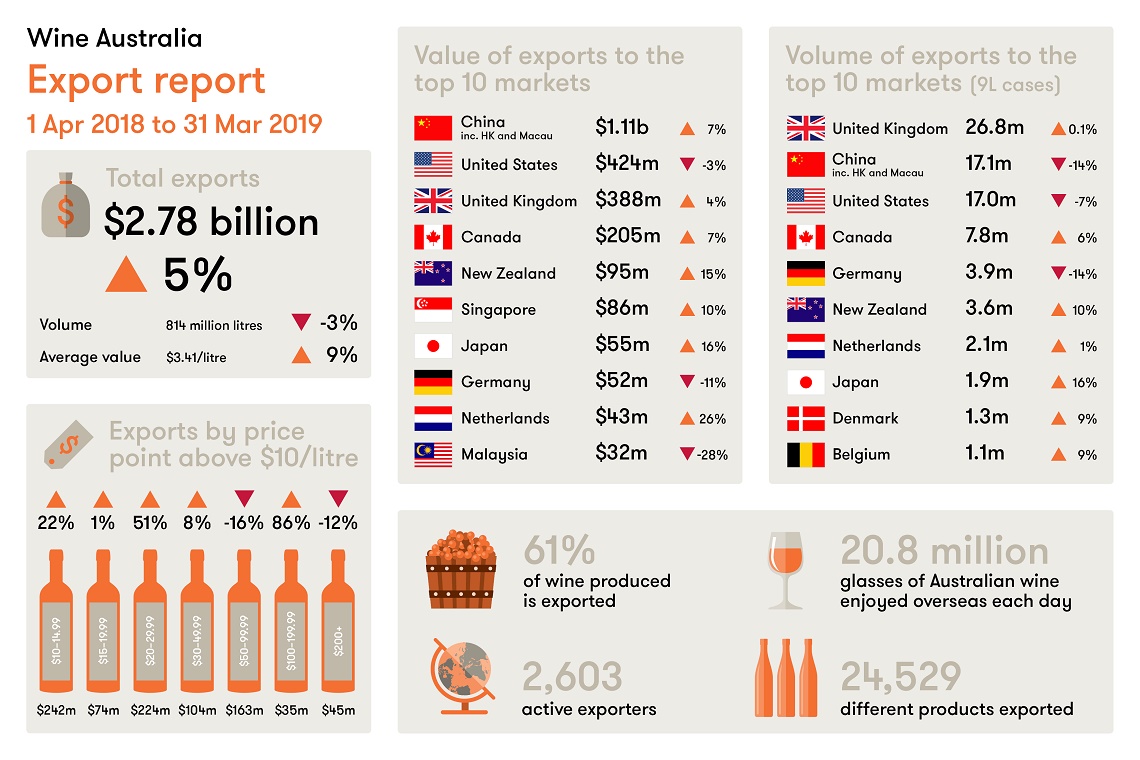By Amy Hayes
The premiumisation trend continues to pay off for Australian wine exports with an upward swing in value for the last 12 months.
The total value of Australian wine exports increased by five per cent to $2.78bn in the 12 months to March 2019, with the average value per litre climbing to $3.41, the highest level since 2009.
While there is a slight decline in overall volume from the market, the trend that consumers are continuing to ‘trade up’ when it comes to spend on wine is a positive step for Australian wine exports.
“What we are seeing is a drop in volumes in the lower value categories and this places Australia well as the global consumer premiumises and drinks less but more expensive wines”, said Wine Australia Chief Executive Officer, Andreas Clark.
In the China market we have grown our value again and we are outperforming competitors, with the Global Trade Atlas figures showing that in the year ended February 2019, Australia had a 29 per cent share of the imported wine market – up from 26 per cent a year ago.
“We are also seeing positive trends in the USA off-trade market where sales of Australian wine grew three per cent in value to US$521m in the year ended December 2018. Even more encouraging is that Australian wine priced above US$15 per bottle has also grown by 3 per cent according to market monitor IRI Worldwide” he added.
In the 12 months to March 2019, there has been strong growth in most per litre price brackets with growth in the $20 – 29 per litre price bracket (51 per cent) and $10 – 14.99 per litre (22 per cent) both lending themselves to the global growth within the premium wine sphere.
Market wise, Australian wine exports to China (including Hong Kong and Macau) have grown by seven per cent in value to reach $1.11bn. Australia is also outperforming competition within export wine to China building on its 26 per cent market share to 29 per cent according to figures by the Global Trade Atlas (year ending February 2019).
Regions that are also seeing growth include –
• Northeast Asia, up eight per cent to $1.2bn,
• Europe, up three per cent to $612m,
• Southeast Asia, up seven per cent to $170m,
• Oceania, up 15 per cent to $107m
• the Middle East, up 16 per cent to $32m
While this is resoundingly positive value wise, volume has taken a significant down turn with key markets such as China being hit with volume pressures decreasing by 14 per cent to 154 million litres (17 million 9-litre case equivalents) in the year ending March 2019. This decline is seen to be affecting almost entirely the below $2.50 per litre value segment which is seen as a result of the tightening of supply in this price segment as well as the continuing pressures from key competitors such as Chile.
Looking forward, Clark said Australian wine supplies would remain tight in the short term with much of the 2018 vintage yet to hit the market and the expectation that 2019 vintage would be below the long-term average.

